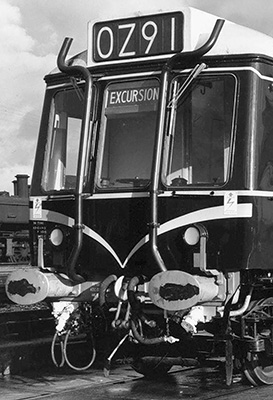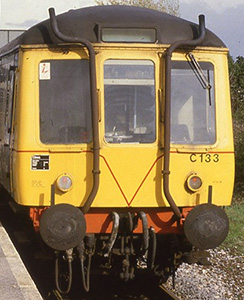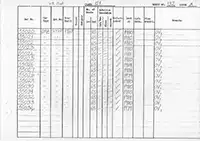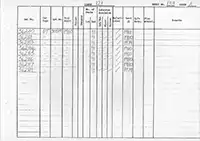Class 121 Pressed Steel Single / 2-car DMUs
Description
Both vehicles had a body length of 64 feet. The Class 121 DMBS can be compared to a Class 117 DMBS an extra cab on the rear.


It seated 65 in two saloons in 2+3 seating, 45 seats in a saloon behind the cab, with a doored partition dividing it from a 20 seat saloon, a further door dividing it from the guard and luggage van. All seating was second class, initially the smaller saloon was designated non-smoking.
The image shows the interior of DMBS 55021 when new, looking from the van end towards the cab.

The DTS was the equivalant of an unpowered Class 117 DMS, with the same internal arrangement (in both un-gangwayed and gangwayed styles). Again it was all second class seating, the front two saloons were identical to the DMBS with 45 and 20 seats, although there was no door fitted to the dividing partition as both saloons were now smoking. There was a door into the 26 seat non-smoking section which was in the place of the guards van / cab on the DMBS, making a total of 91 seats for the vehicle. The rear seat was the full width seating six.
On the outside of the vehicles the two half windows in place of a full window was a sign of where the partitions were inside.

Cab front
A four-character route-indicator box was situated on the roof dome, and this was the flat-top type similar to the majority of Class 117 power cars. It made them easily identifiable from the GRC&W (Class 122) bubble cars.
The destination indicator was at the top of the inside of the center cab window, and was the wooden box type as fitted to most Derby vehicles.
On the number two (van) end of the DMBS were the exhaust pipes, these were distinctly different from the GRC&W bubbles, bending outwards around the route-indicator and becoming known as 'antler' style exhausts.
Two marker lights were always fitted to the lower cab fronts, and there were two horizontal handrails fitted below the two outer cab windscreens and two vertical ones, one on each side of the centre cab windscreen.
Oval buffers were fitted from new.
Power Train
The standard BUT power train was fitted: 150hp engine (AEC type), R14 epicyclic gearbox and F239 final drive. They used the 'Blue Square' control system.
ATC
As Western Region vehicles they would all be fitted with WR ATC (Automatic Train Control) equipment fron new.
Modifications
Buffers
In time the vehicles could be found with the 'cut' type (it was not unknown to have one oval and one 'cut' buffer). Latterly the large round version was the standard.
AWS
In the early 1970s the vehicles were fitted with standard BR AWS equipment, meaning they were now 'Dual AWS' fitted. In the mid-1970s the WR ATC gear would be removed.
Engines
The AEC engines were replaced in the 1970s with the Leyland 680 type (also 150hp). First to be treated was 55026 in 1971, followed by 55025/8 in 1974. Bizzarely 55026 had AECs fitted again in 1976. Beginning 1977 a spares shortage for AEC engines saw BR begin to phase out the AEC engines on many types, including the 121s, and the 680s were fitted to all the DMBSs by 1980.
Refurbishment
The class was included in the 1970s Refurbishment Scheme. All but three vehicles (55035 was now in departmental use and 56282/8 were withdrawn) were treated. The work was done at Swindon Works beginning in early 1979 and being complete by mid-September 1981. The first two vehicles tackled - DMBS (55034) and DTS (56283) - were released in the white/blue stripe livery before the decision was made to abandon these colours and adopt blue/grey as standard.
The works dates for the refurbishments are show in the table, supplied by Eddie Knorn extracted from the BR vehicle record cards.
| Vehicle | Dual AWS | WR ATC removed | Leyland Engines | Refurbished |
|---|---|---|---|---|
| 55020 | circa 11/72 | Jun-75 | p/e 8/10/77 | 29/07/80 |
| 55021 | Oct-73 | Jun-75 | p/e 26/11/77 | 19/09/80 |
| 55022 | Jun-73 | Jun-75 | p/e 26/11/77 | 20/05/80 |
| 55023 | p/e 8/9/73 | Jun-75 | p/e 13/8/77 | 05/12/80 |
| 55024 | 13/8/71 | p/e 6/9/75 | p/e 13/8/77 | 07/07/81 |
| 55025 | 8w/e 1/1/72 | p/e 25/6/77 | Jul-74 | 29/04/80 |
| 55026 | 9/e 31/3/73 | p/e 25/6/77 | Jul-71 (AEC 3/76), p/e 25/6/79 | 23/07/81 |
| 55027 | p/e 29/2/73 | Jun-75 | p/e 26/11/77 | 03/03/81 |
| 55028 | p/e 12/8/72 | Jul-75 | Sep-74 | by Feb-80 |
| 55029 | p/e 28/10/72 | p/e 9/8/75 | p/e 13/8/77 | 18/01/80 |
| 55030 | p/e 31/3/73 | Jul-75 | p/e 8/10/77 | 02/12/80 |
| 55031 | p/e 9/6/73 | Jun-75 | p/e 11/4/78 | 13/08/80 |
| 55032 | 3w/e 1/7/72 | p/e 25/6/77 | p/e 29/3/80 | 10/09/81 |
| 55033 | circa Jul-70 | p/e 25/6/77 | p/e 25/6/79 | 06/10/80 |
| 55034 | circa Jul-70 | p/e 25/6/77 | p/e 25/6/79 | 17/05/79 |
| 55035 | 5w/e 6/10/72 | p/e 8/10/77 | p/e 29/7/78 | - |
| 56280 | circa Jul-70 | Jun-75 | - | 03/03/81 |
| 56281 | 3w/e 29/5/71 | Jun-75 | - | 01/12/80 |
| 56282 | (W in 1972) | - | - | |
| 56283 | p/e 31/3/73 | ? | - | 07/05/79 |
| 56284 | circa Jul-70 | Jun-75 | - | 19/09/80 |
| 56285 | circa Jul-70 | Jun-75 | - | 29/07/80 |
| 56286 | p/e 09/06/73 | Jun-75 | - | 18/01/80 |
| 56287 | p/e 09/06/73 | Jun-75 | - | 20/05/80 |
| 56288 | (W in 1969) | - | - | |
| 56289 | circa Jul-70 | p/e 06/09/75 | - | 01/08/79 |
Air Grilles
Air grilles appeared at the side of the guard's van after refurbishment, these were intakes for the heater for the air that would be heated before flowing into the vehicle. These were originally under the vehicle but prone to drawing in fumes from the heater exhaust, particularly when sitting in platforms, leading to their move.

Replacement Dome
Circa 1980 55033 got a replacement cab roof dome (pictured) on the van (exhaust) end with a destination box rather than a route-indicator (as in the style of a 116 / 122). This was thought to be because of accident damage. It retained the 'antler' style exhuasts, the combination made it easily recognisable (as did the unique Midline livery it would later receive).
Gangways
Just two vehicles were fitted with a gangway, both in 1988 - 54287 in July and 54289 in November. This required dividing the full width seat on the inner end into a pair of two-seaters, reducing seating capacity from 91 to 89.
Cabs
Cab handrails were originally hollow, doubling as a drainpipe for the cantrail gutter, but these were switched for a solid type which no longer went to the cantrail level. Another external change in later days was the addition of high-intensity headlamp in-between the marker lamps.
Door Restraints
Vehicles that remained in passenger use in the 2000s had a secondary door locking system fitted. It involved an extra plate added to extend the doors down to the stepboards where electro-magnets were fitted.
Asbestos
The vehicles were built without blue asbestos. They were included in a vehicle log kept by the RTC at Derby dated circa 1984 which included the asbestos status for each vehicle, the pages of which are included below.
In the asbestos columns the / meant they were not built with blue asbestos, in the remarks column OV meant open van (no cage was fitted).
Summary
Description
Diagrams & Works Photos
Numbering & Driving Inst.
Liveries
Data Panels
Operations
Non-Passenger Use
Images
Details about the preserved Class 121 vehicles can be found here.




